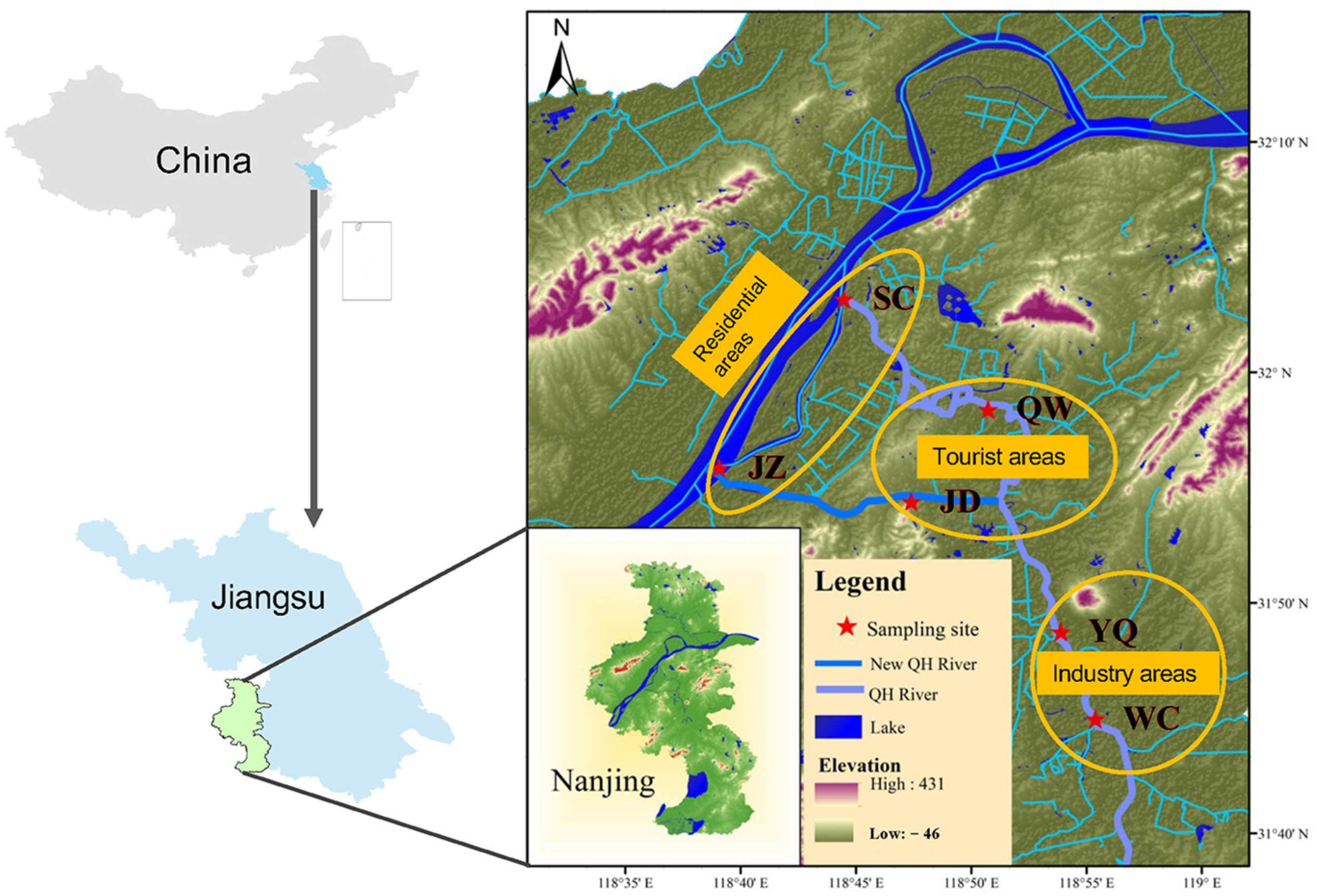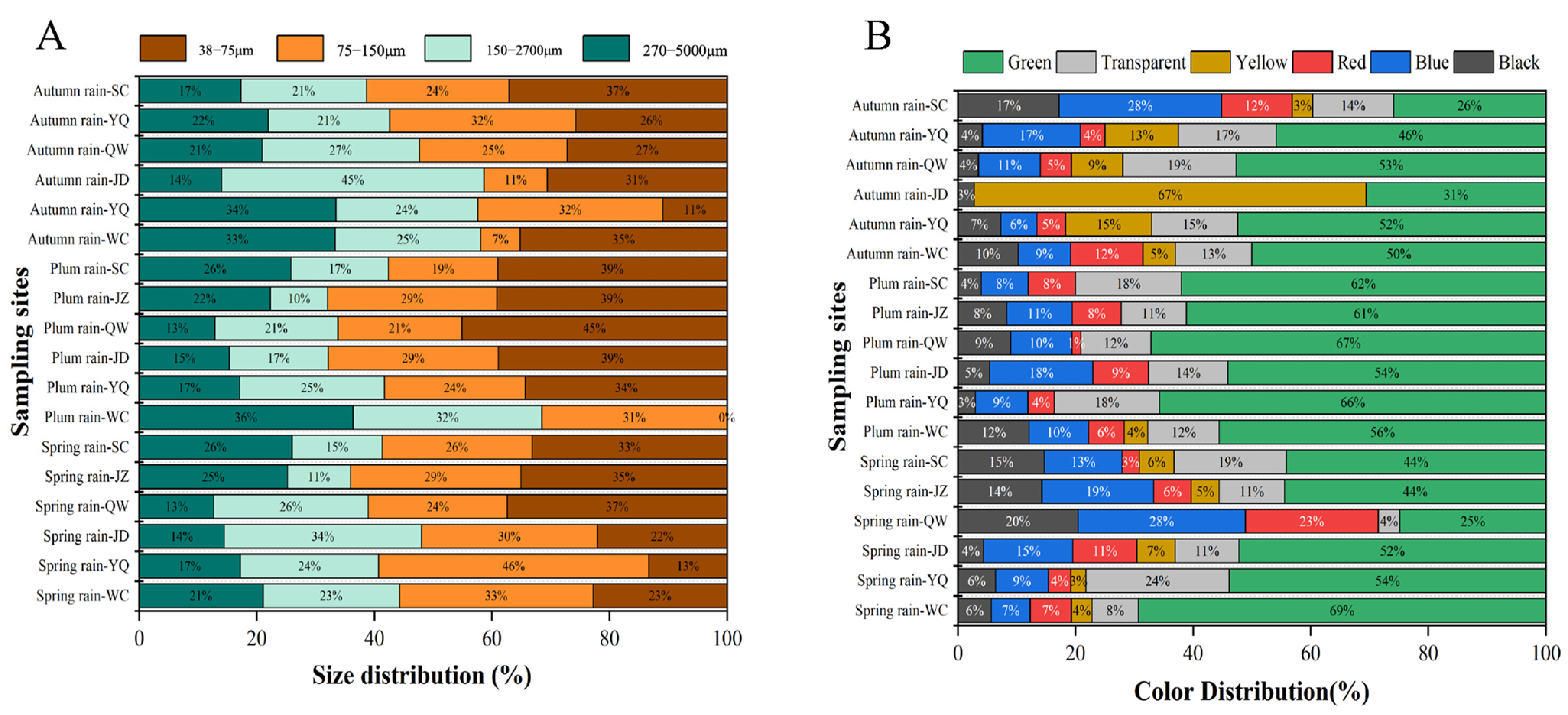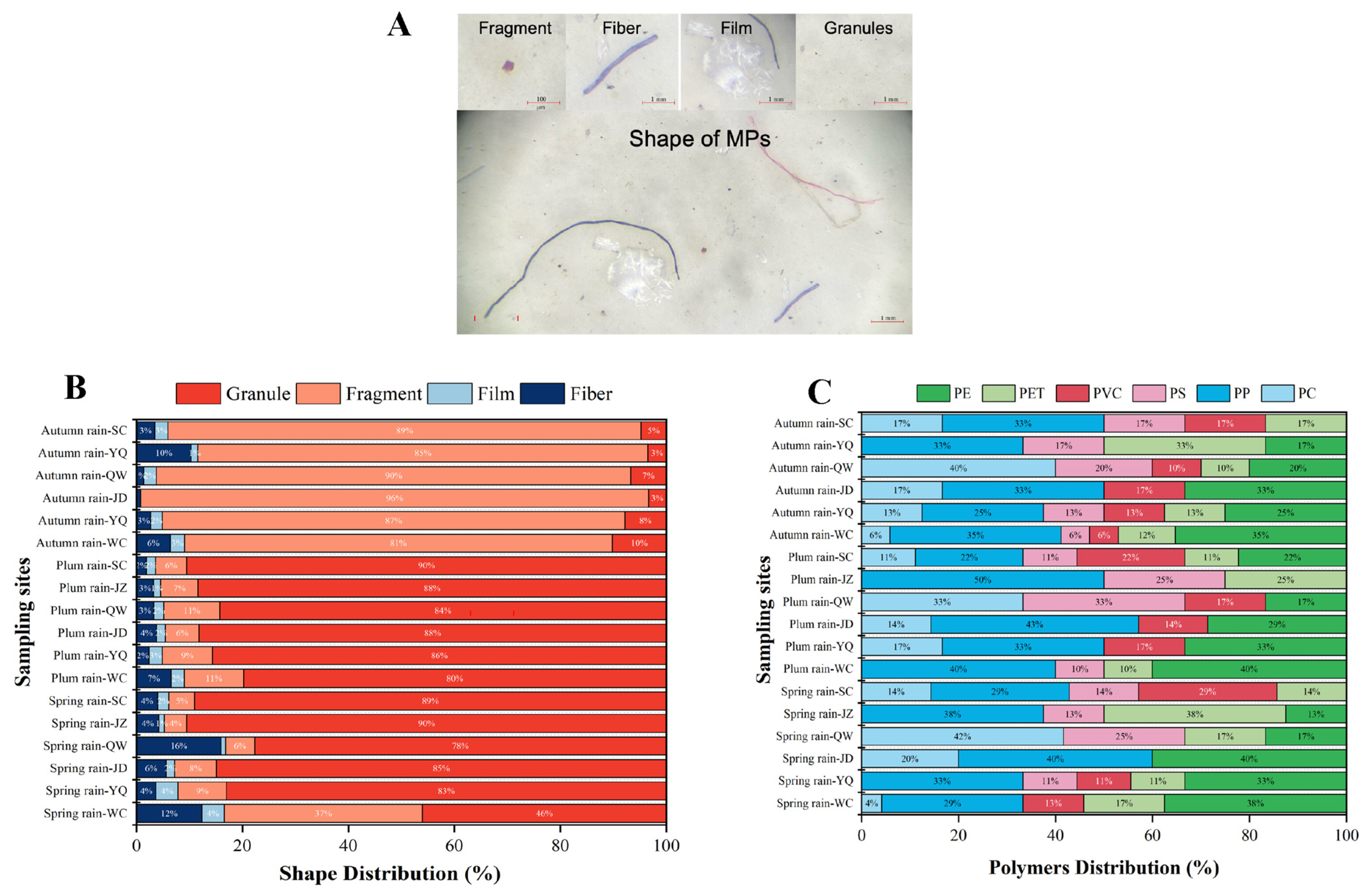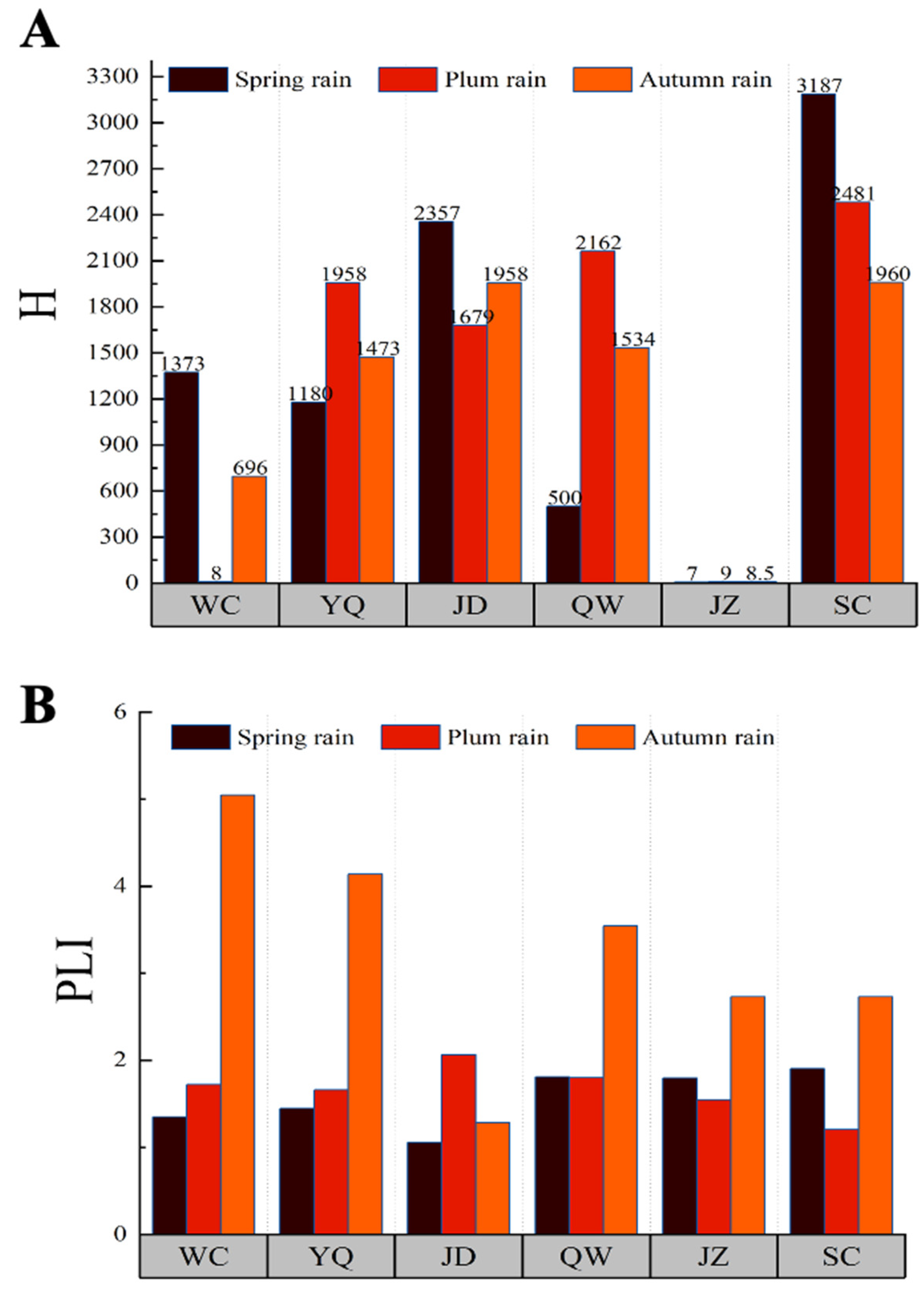Spatial–Temporal and Risk Assessment of Microplastics in the Surface Water of the Qinhuai River during Different Rainfall Seasons in Nanjing City, China
Abstract
1. Introduction
2. Materials and Methods
2.1. Study Area
2.2. Collection of Microplastic Samples
2.3. Identification of Microplastic
2.4. Quality Control
2.5. Microplastic Risk Assessment Method
2.6. Statistical Analysis
3. Result and Discussion
3.1. MP Abundance in the Spatial Distribution
3.2. MP Abundance in Seasonal Variation
3.3. The Characteristics of MPs
3.4. Risk Assessment of Microplastics
4. Conclusions
Supplementary Materials
Author Contributions
Funding
Data Availability Statement
Conflicts of Interest
References
- O’Brien, S.; Rauert, C.; Ribeiro, F.; Okoffo, E.D.; Burrows, S.D.; O’Brien, J.W.; Wang, X.; Wright, S.L.; Thomas, K.V. There’s Something in the Air: A Review of Sources, Prevalence and Behaviour of Microplastics in the Atmosphere. Sci. Total Environ. 2023, 874, 162193. [Google Scholar] [CrossRef]
- Curren, E.; Kuwahara, V.S.; Yoshida, T.; Leong, S.C.Y. Marine Microplastics in the ASEAN Region: A Review of the Current State of Knowledge. Environ. Pollut. 2021, 288, 117776. [Google Scholar] [CrossRef]
- Li, S.; Wang, H.; He, Y.; Liang, D.; Shen, Y.; Gu, Q.; Zeng, Y. How Microplastic Loads Relate to Natural Conditions and Anthropogenic Activities in the Yangtze River Basin. Chemosphere 2023, 342, 140146. [Google Scholar] [CrossRef]
- Koelmans, A.A.; Mohamed Nor, N.H.; Hermsen, E.; Kooi, M.; Mintenig, S.M.; De France, J. Microplastics in Freshwaters and Drinking Water: Critical Review and Assessment of Data Quality. Water Res. 2019, 155, 410–422. [Google Scholar] [CrossRef]
- Sørensen, L.; Rogers, E.; Altin, D.; Salaberria, I.; Booth, A.M. Sorption of PAHs to Microplastic and Their Bioavailability and Toxicity to Marine Copepods under Co-Exposure Conditions. Environ. Pollut. 2020, 258, 113844. [Google Scholar] [CrossRef]
- Brennecke, D.; Duarte, B.; Paiva, F.; Caçador, I.; Canning-Clode, J. Microplastics as Vector for Heavy Metal Contamination from the Marine Environment. Estuar. Coast. Shelf Sci. 2016, 178, 189–195. [Google Scholar] [CrossRef]
- Zheng, Z.; Huang, Y.; Liu, L.; Wang, L.; Tang, J. Interaction between Microplastic Biofilm Formation and Antibiotics: Effect of Microplastic Biofilm and Its Driving Mechanisms on Antibiotic Resistance Gene. J. Hazard. Mater. 2023, 459, 132099. [Google Scholar] [CrossRef]
- Patil, S.M.; Rane, N.R.; Bankole, P.O.; Krishnaiah, P.; Ahn, Y.; Park, Y.-K.; Yadav, K.K.; Amin, M.A.; Jeon, B.-H. An Assessment of Micro- and Nanoplastics in the Biosphere: A Review of Detection, Monitoring, and Remediation Technology. Chem. Eng. J. 2022, 430, 132913. [Google Scholar] [CrossRef]
- Samandra, S.; Singh, J.; Plaisted, K.; Mescall, O.J.; Symons, B.; Xie, S.; Ellis, A.V.; Clarke, B.O. Quantifying Environmental Emissions of Microplastics from Urban Rivers in Melbourne, Australia. Mar. Pollut. Bull. 2023, 189, 114709. [Google Scholar] [CrossRef]
- Rodrigues, M.O.; Abrantes, N.; Gonçalves, F.J.M.; Nogueira, H.; Marques, J.C.; Gonçalves, A.M.M. Spatial and Temporal Distribution of Microplastics in Water and Sediments of a Freshwater System (Antuã River, Portugal). Sci. Total Environ. 2018, 633, 1549–1559. [Google Scholar] [CrossRef]
- Han, M.; Niu, X.; Tang, M.; Zhang, B.-T.; Wang, G.; Yue, W.; Kong, X.; Zhu, J. Distribution of Microplastics in Surface Water of the Lower Yellow River near Estuary. Sci. Total Environ. 2020, 707, 135601. [Google Scholar] [CrossRef]
- Yan, M.; Nie, H.; Xu, K.; He, Y.; Hu, Y.; Huang, Y.; Wang, J. Microplastic Abundance, Distribution and Composition in the Pearl River along Guangzhou City and Pearl River Estuary, China. Chemosphere 2019, 217, 879–886. [Google Scholar] [CrossRef]
- Jambeck, J.R.; Geyer, R.; Wilcox, C.; Siegler, T.R.; Perryman, M.; Andrady, A.; Narayan, R.; Law, K.L. Plastic Waste Inputs from Land into the Ocean. Science 2015, 347, 768–771. [Google Scholar] [CrossRef]
- Meijer, L.J.J.; Van Emmerik, T.; Van Der Ent, R.; Schmidt, C.; Lebreton, L. More than 1000 Rivers Account for 80% of Global Riverine Plastic Emissions into the Ocean. Sci. Adv. 2021, 7, eaaz5803. [Google Scholar] [CrossRef]
- Dai, L.; Wang, Z.; Guo, T.; Hu, L.; Chen, Y.; Chen, C.; Yu, G.; Ma, L.Q.; Chen, J. Pollution Characteristics and Source Analysis of Microplastics in the Qiantang River in Southeastern China. Chemosphere 2022, 293, 133576. [Google Scholar] [CrossRef]
- Sol, D.; Laca, A.; Laca, A.; Díaz, M. Approaching the Environmental Problem of Microplastics: Importance of WWTP Treatments. Sci. Total Environ. 2020, 740, 140016. [Google Scholar] [CrossRef]
- Mani, T.; Burkhardt-Holm, P. Seasonal Microplastics Variation in Nival and Pluvial Stretches of the Rhine River—From the Swiss Catchment towards the North Sea. Sci. Total Environ. 2020, 707, 135579. [Google Scholar] [CrossRef]
- Xia, F.; Wang, Y.; Wang, D.; Cai, Y.; Zhang, J. Seasonal Pulse Effect of Microplastics in the River Catchment-From Tributary Catchment to Mainstream. J. Environ. Manag. 2023, 342, 118316. [Google Scholar] [CrossRef]
- Wang, G.; Lu, J.; Li, W.; Ning, J.; Zhou, L.; Tong, Y.; Liu, Z.; Zhou, H.; Xiayihazi, N. Seasonal Variation and Risk Assessment of Microplastics in Surface Water of the Manas River Basin, China. Ecotoxicol. Environ. Saf. 2021, 208, 111477. [Google Scholar] [CrossRef] [PubMed]
- Xia, F.; Yao, Q.; Zhang, J.; Wang, D. Effects of Seasonal Variation and Resuspension on Microplastics in River Sediments. Environ. Pollut. 2021, 286, 117403. [Google Scholar] [CrossRef] [PubMed]
- Blettler, M.C.M.; Abrial, E.; Khan, F.R.; Sivri, N.; Espinola, L.A. Freshwater Plastic Pollution: Recognizing Research Biases and Identifying Knowledge Gaps. Water Res. 2018, 143, 416–424. [Google Scholar] [CrossRef] [PubMed]
- Lemma, T.M.; Gessesse, G.D.; Kassa, A.K.; Edossa, D.C. Effect of Spatial Scale on Runoff Coefficient: Evidence from the Ethiopian Highlands. Int. Soil Water Conserv. Res. 2018, 6, 289–296. [Google Scholar] [CrossRef]
- Lin, L.; Zuo, L.-Z.; Peng, J.-P.; Cai, L.-Q.; Fok, L.; Yan, Y.; Li, H.-X.; Xu, X.-R. Occurrence and Distribution of Microplastics in an Urban River: A Case Study in the Pearl River along Guangzhou City, China. Sci. Total Environ. 2018, 644, 375–381. [Google Scholar] [CrossRef]
- Cheung, P.K.; Cheung, L.T.O.; Fok, L. Seasonal Variation in the Abundance of Marine Plastic Debris in the Estuary of a Subtropical Macro-Scale Drainage Basin in South China. Sci. Total Environ. 2016, 562, 658–665. [Google Scholar] [CrossRef]
- Le, X.T.T.; Nguyen, D.T.; Pham, M.T.; Trinh, M.V.; Le, P.C.; Do, V.M. Risk Assessment of Microplastic Exposure: A Case Study near a Refinery Factory at the Central Coast of Vietnam. Mar. Pollut. Bull. 2023, 196, 115636. [Google Scholar] [CrossRef]
- Lithner, D.; Larsson, Å.; Dave, G. Environmental and Health Hazard Ranking and Assessment of Plastic Polymers Based on Chemical Composition. Sci. Total Environ. 2011, 409, 3309–3324. [Google Scholar] [CrossRef]
- Kabir, A.H.M.E.; Sekine, M.; Imai, T.; Yamamoto, K.; Kanno, A.; Higuchi, T. Microplastics in the Sediments of Small-Scale Japanese Rivers: Abundance and Distribution, Characterization, Sources-to-Sink, and Ecological Risks. Sci. Total Environ. 2022, 812, 152590. [Google Scholar] [CrossRef]
- Tomlinson, D.L.; Wilson, J.G.; Harris, C.R.; Jeffrey, D.W. Problems in the Assessment of Heavy-Metal Levels in Estuaries and the Formation of a Pollution Index. Helgol. Meeresunters 1980, 33, 566–575. [Google Scholar] [CrossRef]
- Wu, N.; Zhang, Y.; Zhang, X.; Zhao, Z.; He, J.; Li, W.; Ma, Y.; Niu, Z. Occurrence and Distribution of Microplastics in the Surface Water and Sediment of Two Typical Estuaries in Bohai Bay, China. Environ. Sci. Process. Impacts 2019, 21, 1143–1152. [Google Scholar] [CrossRef] [PubMed]
- Rakib, M.R.J.; Al Nahian, S.; Madadi, R.; Haider, S.M.B.; De-la-Torre, G.E.; Walker, T.R.; Jonathan, M.P.; Cowger, W.; Khandaker, M.U.; Idris, A.M. Spatiotemporal Trends and Characteristics of Microplastic Contamination in a Large River-Dominated Estuary. Environ. Sci. Process. Impacts 2023, 25, 929–940. [Google Scholar] [CrossRef]
- Liu, K.; Wang, X.; Fang, T.; Xu, P.; Zhu, L.; Li, D. Source and Potential Risk Assessment of Suspended Atmospheric Microplastics in Shanghai. Sci. Total Environ. 2019, 675, 462–471. [Google Scholar] [CrossRef] [PubMed]
- Isobe, A.; Kubo, K.; Tamura, Y.; Kako, S.; Nakashima, E.; Fujii, N. Selective Transport of Microplastics and Mesoplastics by Drifting in Coastal Waters. Mar. Pollut. Bull. 2014, 89, 324–330. [Google Scholar] [CrossRef] [PubMed]
- Eo, S.; Hong, S.H.; Song, Y.K.; Han, G.M.; Shim, W.J. Spatiotemporal Distribution and Annual Load of Microplastics in the Nakdong River, South Korea. Water Res. 2019, 160, 228–237. [Google Scholar] [CrossRef] [PubMed]
- Devereux, R.; Westhead, E.K.; Jayaratne, R.; Newport, D. Microplastic Abundance in the Thames River during the New Year Period. Mar. Pollut. Bull. 2022, 177, 113534. [Google Scholar] [CrossRef]
- Yuan, W.; Liu, X.; Wang, W.; Di, M.; Wang, J. Microplastic Abundance, Distribution and Composition in Water, Sediments, and Wild Fish from Poyang Lake, China. Ecotoxicol. Environ. Saf. 2019, 170, 180–187. [Google Scholar] [CrossRef] [PubMed]
- Zhao, H.; Li, P.; He, X.; Ning, J. Microplastics Pollution and Risk Assessment in Selected Surface Waters of the Wei River Plain, China. Expo Health 2022, 15, 745–755. [Google Scholar] [CrossRef]
- Chen, C.; Deng, J.; Zhang, Q.; Cai, J. Microplastic Pollution and Characteristics in the Surface Waters of the Middle and Lower Reaches of the Han River along Hubei Province, China. Int. J. Environ. Sci. Technol. 2023, 20, 10205–10216. [Google Scholar] [CrossRef]
- Ramasamy, R.; Aragaw, T.A.; Balasaraswathi Subramanian, R. Wastewater Treatment Plant Effluent and Microfiber Pollution: Focus on Industry-Specific Wastewater. Environ. Sci. Pollut. Res. 2022, 29, 51211–51233. [Google Scholar] [CrossRef] [PubMed]
- Wang, T.; Qu, L.; Luo, D.; Ji, X.; Ma, Z.; Wang, Z.; Dahlgren, R.A.; Zhang, M.; Shang, X. Microplastic Pollution Characteristics and Its Future Perspectives in the Tibetan Plateau. J. Hazard. Mater. 2023, 457, 131711. [Google Scholar] [CrossRef]
- Jessieleena, A.; Rathinavelu, S.; Velmaiel, K.E.; John, A.A.; Nambi, I.M. Residential Houses—A Major Point Source of Microplastic Pollution: Insights on the Various Sources, Their Transport, Transformation, and Toxicity Behaviour. Environ. Sci. Pollut. Res. 2023, 30, 67919–67940. [Google Scholar] [CrossRef]
- Watkins, L.; McGrattan, S.; Sullivan, P.J.; Walter, M.T. The Effect of Dams on River Transport of Microplastic Pollution. Sci. Total Environ. 2019, 664, 834–840. [Google Scholar] [CrossRef] [PubMed]
- Turner, A.; Holmes, L. Occurrence, Distribution and Characteristics of Beached Plastic Production Pellets on the Island of Malta (Central Mediterranean). Mar. Pollut. Bull. 2011, 62, 377–381. [Google Scholar] [CrossRef] [PubMed]
- Li, C.; Shi, Y.; Luo, D.; Kang, M.; Li, Y.; Huang, Y.; Bai, X. Interventions of River Network Structures on Urban Aquatic Microplastic Footprint from a Connectivity Perspective. Water Res. 2023, 243, 120418. [Google Scholar] [CrossRef] [PubMed]
- Wang, S.; Rao, W.; Qian, J.; Jin, K.; Li, K.; Feng, Y.; Zhao, J. Identifying the Provenance of Bottom Sediments in the Three Gorges Reservoir Using Stable Pb Isotopes. CATENA 2021, 207, 105656. [Google Scholar] [CrossRef]
- Ma, H.; Pu, S.; Liu, S.; Bai, Y.; Mandal, S.; Xing, B. Microplastics in Aquatic Environments: Toxicity to Trigger Ecological Consequences. Environ. Pollut. 2020, 261, 114089. [Google Scholar] [CrossRef] [PubMed]
- Wright, S.L.; Thompson, R.C.; Galloway, T.S. The Physical Impacts of Microplastics on Marine Organisms: A Review. Environ. Pollut. 2013, 178, 483–492. [Google Scholar] [CrossRef] [PubMed]
- Buwono, N.R.; Risjani, Y.; Soegianto, A. Distribution of Microplastic in Relation to Water Quality Parameters in the Brantas River, East Java, Indonesia. Environ. Technol. Innov. 2021, 24, 101915. [Google Scholar] [CrossRef]
- Fan, Y.; Zheng, J.; Deng, L.; Rao, W.; Zhang, Q.; Liu, T.; Qian, X. Spatiotemporal Dynamics of Microplastics in an Urban River Network Area. Water Res. 2022, 212, 118116. [Google Scholar] [CrossRef] [PubMed]
- Takdastan, A.; Niari, M.H.; Babaei, A.; Dobaradaran, S.; Jorfi, S.; Ahmadi, M. Occurrence and Distribution of Microplastic Particles and the Concentration of Di 2-Ethyl Hexyl Phthalate (DEHP) in Microplastics and Wastewater in the Wastewater Treatment Plant. J. Environ. Manag. 2021, 280, 111851. [Google Scholar] [CrossRef]
- Ding, J.; Jiang, F.; Li, J.; Wang, Z.; Sun, C.; Wang, Z.; Fu, L.; Ding, N.X.; He, C. Microplastics in the Coral Reef Systems from Xisha Islands of South China Sea. Environ. Sci. Technol. 2019, 53, 8036–8046. [Google Scholar] [CrossRef]
- Li, R.; Yu, L.; Chai, M.; Wu, H.; Zhu, X. The Distribution, Characteristics and Ecological Risks of Microplastics in the Mangroves of Southern China. Sci. Total Environ. 2020, 708, 135025. [Google Scholar] [CrossRef] [PubMed]
- Shu, X.; Xu, L.; Yang, M.; Qin, Z.; Zhang, Q.; Zhang, L. Spatial Distribution Characteristics and Migration of Microplastics in Surface Water, Groundwater and Sediment in Karst Areas: The Case of Yulong River in Guilin, Southwest China. Sci. Total Environ. 2023, 868, 161578. [Google Scholar] [CrossRef] [PubMed]
- Huang, J.; Wang, L.; Liu, J.; Qian, X.; Wu, Y. Abundance, Characteristics, and Removal of Microplastics in Different Wastewater Treatment Plants in a Yangtze River Delta City of China. J. Water Process Eng. 2023, 54, 103987. [Google Scholar] [CrossRef]
- Gan, M.; Zhang, Y.; Shi, P.; Cui, L.; Sun, H. Microplastic Pollution in Typical Seasonal Rivers in Northern China: Temporal Variation and Risk Assessment. Environ. Sci. Process. Impacts 2023, 25, 1479–1490. [Google Scholar] [CrossRef]
- Hafeez, S.; Qadir, A.; Aslam, M.; Aslam, H.M.U.; Rehmat, M.S.; Ahmad, S.R. Environmental Risks of Microplastics on the Spatial and Temporal Gradient in a River Originating from the Western Himalayas. Environ. Toxicol. Chem. 2023, 42, 727–739. [Google Scholar] [CrossRef]






Disclaimer/Publisher’s Note: The statements, opinions and data contained in all publications are solely those of the individual author(s) and contributor(s) and not of MDPI and/or the editor(s). MDPI and/or the editor(s) disclaim responsibility for any injury to people or property resulting from any ideas, methods, instructions or products referred to in the content. |
© 2024 by the authors. Licensee MDPI, Basel, Switzerland. This article is an open access article distributed under the terms and conditions of the Creative Commons Attribution (CC BY) license (https://creativecommons.org/licenses/by/4.0/).
Share and Cite
Wang, L.; Huang, J.; Wu, Y.; Chen, X.; Chen, M.; Jin, H.; Yao, J.; Wang, X. Spatial–Temporal and Risk Assessment of Microplastics in the Surface Water of the Qinhuai River during Different Rainfall Seasons in Nanjing City, China. Water 2024, 16, 1857. https://doi.org/10.3390/w16131857
Wang L, Huang J, Wu Y, Chen X, Chen M, Jin H, Yao J, Wang X. Spatial–Temporal and Risk Assessment of Microplastics in the Surface Water of the Qinhuai River during Different Rainfall Seasons in Nanjing City, China. Water. 2024; 16(13):1857. https://doi.org/10.3390/w16131857
Chicago/Turabian StyleWang, Luming, Juan Huang, Yufeng Wu, Xuan Chen, Ming Chen, Hui Jin, Jiawei Yao, and Xinyue Wang. 2024. "Spatial–Temporal and Risk Assessment of Microplastics in the Surface Water of the Qinhuai River during Different Rainfall Seasons in Nanjing City, China" Water 16, no. 13: 1857. https://doi.org/10.3390/w16131857
APA StyleWang, L., Huang, J., Wu, Y., Chen, X., Chen, M., Jin, H., Yao, J., & Wang, X. (2024). Spatial–Temporal and Risk Assessment of Microplastics in the Surface Water of the Qinhuai River during Different Rainfall Seasons in Nanjing City, China. Water, 16(13), 1857. https://doi.org/10.3390/w16131857





